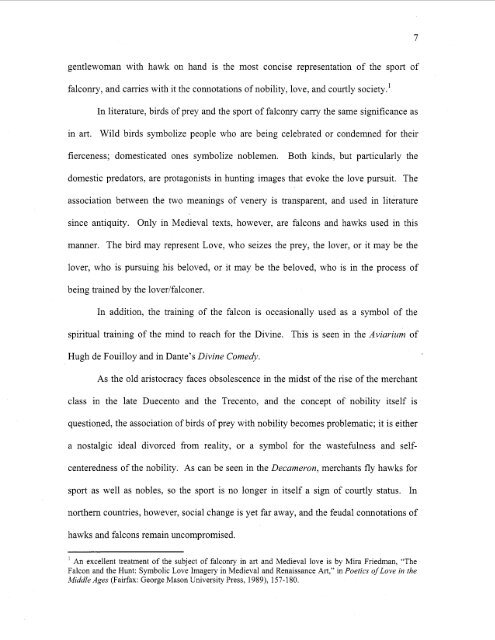Birds of Prey and the Sport of Falconry in Italian Literature through ...
Birds of Prey and the Sport of Falconry in Italian Literature through ...
Birds of Prey and the Sport of Falconry in Italian Literature through ...
Create successful ePaper yourself
Turn your PDF publications into a flip-book with our unique Google optimized e-Paper software.
gentlewoman with hawk on h<strong>and</strong> is <strong>the</strong> most concise representation <strong>of</strong> <strong>the</strong> sport <strong>of</strong><br />
falconry, <strong>and</strong> carries with it <strong>the</strong> connotations <strong>of</strong> nobility, love, <strong>and</strong> courtly society.'<br />
In literature, birds <strong>of</strong> prey <strong>and</strong> <strong>the</strong> sport <strong>of</strong> falconry carry <strong>the</strong> same significance as<br />
<strong>in</strong> art. Wild birds symbolize people who are be<strong>in</strong>g celebrated or condemned for <strong>the</strong>ir<br />
fierceness; domesticated ones symbolize noblemen. Both k<strong>in</strong>ds, but particularly <strong>the</strong><br />
domestic predators, are protagonists <strong>in</strong> hunt<strong>in</strong>g images that evoke <strong>the</strong> love pursuit. The<br />
association between <strong>the</strong> two mean<strong>in</strong>gs <strong>of</strong> venery is transparent, <strong>and</strong> used <strong>in</strong> literature<br />
s<strong>in</strong>ce antiquity. Only <strong>in</strong> Medieval texts, however, are falcons <strong>and</strong> hawks used <strong>in</strong> this<br />
manner. The bird may represent Love, who seizes <strong>the</strong> prey, <strong>the</strong> lover, or it may be <strong>the</strong><br />
lover, who is pursu<strong>in</strong>g his beloved, or it may be <strong>the</strong> beloved, who is <strong>in</strong> <strong>the</strong> process <strong>of</strong><br />
be<strong>in</strong>g tra<strong>in</strong>ed by <strong>the</strong> lover/falconer.<br />
In addition, <strong>the</strong> tra<strong>in</strong><strong>in</strong>g <strong>of</strong> <strong>the</strong> falcon is occasionally used as a symbol <strong>of</strong> <strong>the</strong><br />
spiritual tra<strong>in</strong><strong>in</strong>g <strong>of</strong> <strong>the</strong> m<strong>in</strong>d to reach for <strong>the</strong> Div<strong>in</strong>e. This is seen <strong>in</strong> <strong>the</strong> Aviarium <strong>of</strong><br />
Hugh de Fouilloy <strong>and</strong> <strong>in</strong> Dante's Div<strong>in</strong>e Comedy.<br />
As <strong>the</strong> old aristocracy faces obsolescence <strong>in</strong> <strong>the</strong> midst <strong>of</strong> <strong>the</strong> rise <strong>of</strong> <strong>the</strong> merchant<br />
class <strong>in</strong> <strong>the</strong> late Duecento <strong>and</strong> <strong>the</strong> Trecento, <strong>and</strong> <strong>the</strong> concept <strong>of</strong> nobility itself is<br />
questioned, <strong>the</strong> association <strong>of</strong> birds <strong>of</strong> prey with nobility becomes problematic; it is ei<strong>the</strong>r<br />
a nostalgic ideal divorced from reality, or a symbol for <strong>the</strong> wastefulness <strong>and</strong> self-<br />
centeredness <strong>of</strong> <strong>the</strong> nobility. As can be seen <strong>in</strong> <strong>the</strong> Decameron, merchants fly hawks for<br />
sport as well as nobles, so <strong>the</strong> sport is no longer <strong>in</strong> itself a sign <strong>of</strong> courtly status. In<br />
nor<strong>the</strong>rn countries, however, social change is yet far away, <strong>and</strong> <strong>the</strong> feudal connotations <strong>of</strong><br />
hawks <strong>and</strong> falcons rema<strong>in</strong> uncompromised.<br />
' An excellent treatment <strong>of</strong> <strong>the</strong> subject <strong>of</strong> falconry <strong>in</strong> art <strong>and</strong> Medieval love is by Mira Friedman, "The<br />
Falcon <strong>and</strong> <strong>the</strong> Hunt: Symbolic Love Imagery <strong>in</strong> Medieval <strong>and</strong> Renaissance Art," <strong>in</strong> Poetics <strong>of</strong>Love <strong>in</strong> <strong>the</strong><br />
Middle Ages (Fairfax: George Mason University Press, 1989), 157- 180.


